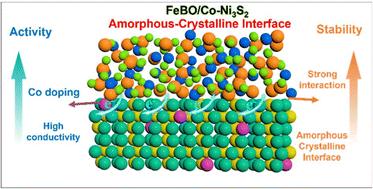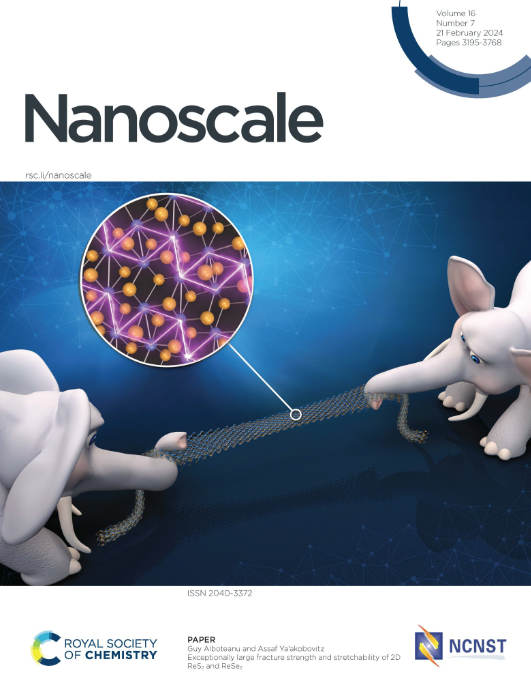Deep reconstruction of crystalline–amorphous heterojunction electrocatalysts for efficient and stable water and methanol electrolysis
IF 5.8
3区 材料科学
Q1 CHEMISTRY, MULTIDISCIPLINARY
引用次数: 0
Abstract
During electrocatalytic water splitting, surface reconstruction often occurs to generate truly active species for catalytic reactions, but the stability and mass activity of the catalysts is a huge challenge. A method that combines cation doping with morphology control strategies and constructs an amorphous–crystalline heterostructure is proposed to achieve deep reconstruction of the catalyst during the electrochemical activation process, thereby significantly improving catalytic activity and stability. Amorphous iron borate (FeBO) is deposited on cobalt-doped nickel sulfide (Co-Ni3S2) crystals to form ultrathin nanosheet heterostructures (FeBO/Co-Ni3S2) as bifunctional electrocatalysts for the OER and methanol oxidation reaction (MOR). During the OER process, FeBO/Co-Ni3S2 is deeply reconstructed to form a NiFeOOH/Co-Ni3S2 composite structure with ultrathin nanosheets with abundant amorphous–crystalline interfaces to ensure structural stability. Furthermore, Co-Ni3S2 electrocatalysts were synthesized via nickel foam (NF) self-derivation, which resulted in strong adhesion between the catalyst and substrate and formed a hierarchical structure consisting of interconnected nanosheets with excellent mass transfer and abundant active sites to increase the activity and stability of the electrocatalyst. The dual-electrode electrolyzer requires cell voltages of 1.58 and 1.44 V to achieve water and methanol overall electrolysis at a current density of 10 mA cm−2 and keep working over 100 and 25 h, respectively. This strategy provides a new way to promote reconstruction to construct excellent bifunctional electrocatalysts.

深度重构晶体-非晶态异质结电催化剂,实现高效稳定的水和甲醇电解
在电催化分水过程中,经常会发生表面重构,以产生真正的活性物种进行催化反应,但催化剂的稳定性和质量活性是一个巨大的挑战。本研究提出了一种将阳离子掺杂与形态控制策略相结合并构建非晶-晶体异质结构的方法,以在电化学活化过程中实现催化剂的深度重构,从而显著提高催化活性和稳定性。无定形硼酸铁(FeBO)沉积在掺钴硫化镍(Co-Ni3S2)晶体上,形成超薄纳米片状异质结构(FeBO/Co-Ni3S2),作为 OER 和甲醇氧化反应(MOR)的双功能电催化剂。在 OER 过程中,FeBO/Co-Ni3S2 深度重构,形成 NiFeOOH/CoNi3S2 复合结构,其超薄纳米片具有丰富的非晶-晶体界面,确保了结构的稳定性。此外,通过镍泡沫(NF)自钝化合成了 Co-Ni3S2 电催化剂,催化剂与基底之间的粘附性很强,形成了由相互连接的纳米片组成的分层结构,具有良好的传质性能和丰富的活性位点,从而提高了电催化剂的活性和稳定性。双电极电解槽需要 1.58 和 1.44 V 的电池电压,才能在 10 mA cm-2 的电流密度下实现水和甲醇的整体电解,并分别持续工作 100 和 25 小时。这一策略为促进重构以构建优异的双功能电催化剂提供了新的途径。
本文章由计算机程序翻译,如有差异,请以英文原文为准。
求助全文
约1分钟内获得全文
求助全文
来源期刊

Nanoscale
CHEMISTRY, MULTIDISCIPLINARY-NANOSCIENCE & NANOTECHNOLOGY
CiteScore
12.10
自引率
3.00%
发文量
1628
审稿时长
1.6 months
期刊介绍:
Nanoscale is a high-impact international journal, publishing high-quality research across nanoscience and nanotechnology. Nanoscale publishes a full mix of research articles on experimental and theoretical work, including reviews, communications, and full papers.Highly interdisciplinary, this journal appeals to scientists, researchers and professionals interested in nanoscience and nanotechnology, quantum materials and quantum technology, including the areas of physics, chemistry, biology, medicine, materials, energy/environment, information technology, detection science, healthcare and drug discovery, and electronics.
 求助内容:
求助内容: 应助结果提醒方式:
应助结果提醒方式:


